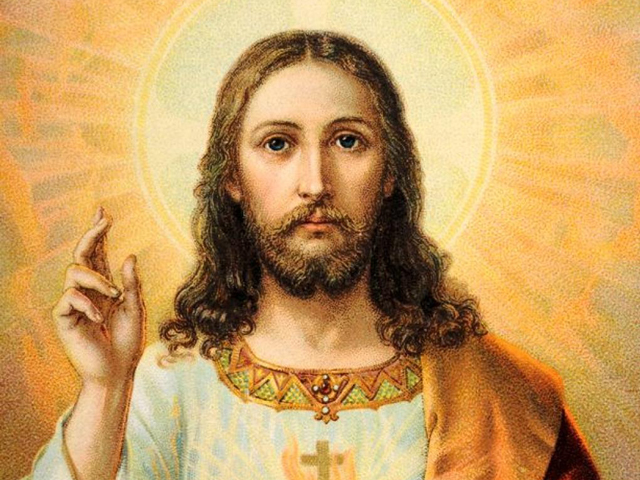
Icon, savior, prophet, rabbi, messiah, son of God. Whatever your personal beliefs and your view of who this man from Nazareth was (or is), there’s no denying that Jesus Christ is a figure who has shaped the course of human history. Some believe in his divinity, while others just view him as an influential historical figure. But still, whether you accept belief in him or not, his influence is felt in all of our lives; sadly, sometimes in very negative ways. Perhaps the most powerful influence of Christ can be found in art. Pretty much every great and influential artist of the past millennia has taken their shot at depicting Christ in some way; in painting, sculpture, carvings, performance, and of course, cinema. Jesus has proven to be just as powerful figure on the silver screen as he has been in any other artistic medium. At the same time, he is also one of the trickiest roles to fill. A lot of pressure falls on those who puts on the robes to portray Christ, because if they do a poor job, they run the risk of upsetting a multitude of the faithful, most of whom take the image of Christ very seriously. Some movies sometimes even take careful measures to avoid any controversy at all by showing Jesus either from a distance, like in Monty Python’s Life of Brian (1979) or from over the shoulder without showing his face, like in Ben-Hur (1959). But, there are plenty of films that do take the risk of not only showing Christ on screen, but also delving deep into his story and analyzing what kind of person he was. What’s most interesting is how different eras of cinema have incredibly different views on the figure of Christ. In this article, I will be looking at a few of these, limited solely to depictions from Hollywood; so no international depictions, or TV movie adaptations, nor any Christploitation films the Christian film market. So let’s look at Jesus Christ’s journey as a cinematic icon.
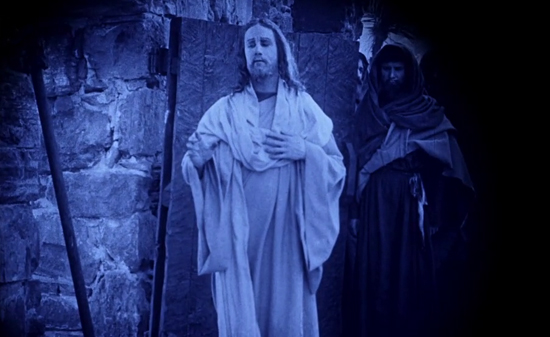
HOWARD GAYE from D.W. GRIFFITH’S INTOLERANCE (1916)
For an examination of Christ’s presence on the silver screen, it’s fitting to look back and see one of the earliest. In D. W. Griffith’s now century old epic, we are presented with four interlocking stories depicting different eras in world history, all centered around the theme of intolerance. The shortest of these story-lines is devoted to the story of Jesus, and his persecution at the hands of the Pharisee priests who are determined to silence his ministry. The story is sadly limited, but the depiction of Christ is nevertheless interesting in the film. Actor Howard Gaye certainly was cast based on his resemblance to the commonly accepted image of Jesus in centuries of artwork. Through Griffith’s film, we see the icon of Jesus that was familiar to the world through it’s artwork brought to life through the magic of cinema. Because of Griffith’s film, this image of a long faced, flowing hair, and white robed Jesus would endure into the realm of cinema and influence all future depictions from then on. It’s an interesting aspect that Griffith chose to use the image of Christ in his grand statement on the nature of intolerance. Though brief, Christ’s story is interconnected with stories of the fall of the Babylonian Empire, religious wars in Renaissance era France, and a present day story of religious zealots breaking apart a disadvantaged family. What I think Griffith misses however in his film is the irony that the persecution that each of his main characters face is done in the name of someone who went through the same persecution. I think Griffith was more interested in the cruel cycle of intolerance that humanity has faced over the years, and he viewed Jesus’ own persecution as one chapter of that.

H. B. WARNER from THE KING OF KINGS (1927)
Later on in the silent era, we were given a much more substantial portrayal of Jesus Christ on film, which came from a filmmaker who is now synonymous with the biblical epic genre; Cecil B. DeMille. DeMille was already established filmmaker at this point in his career, and had already won praise for bringing The Ten Commandments (1923) to the big screen. But, many consider his depiction of Jesus Christ in The King of Kings to be one of his greatest achievements. Here we find a Christ that is both humane and divine; relateable and yet also ethereal. It is certainly one of the more idealized versions of Christ that we’ve seen on film, with actor H. B. Warner giving a standout performance. Warner fits the same image iconic image of Christ, but what he brings is more sophistication to his portrayal, making him feel more human and personable. It’s clearly DeMille’s to utilize the cinematic medium to present Jesus is the most sympathetic light possible. Here, Christ almost glows on screen, with DeMille using diffused lighting to spotlight Christ and make him standout from everyone else. Even the Resurrection of Christ utilized some remarkable cinematic tricks, with DeMille inter-cutting a Technicolor sunrise into the scene (color photography was only recently introduced and was considered cutting edge for it’s time, making the shot all the more special). Though old fashioned by today’s standards, DeMille’s epic became a gold standard for the depiction of Christ on film for many years to come, and it is still to this day one of the most cinematic-ally pleasing.
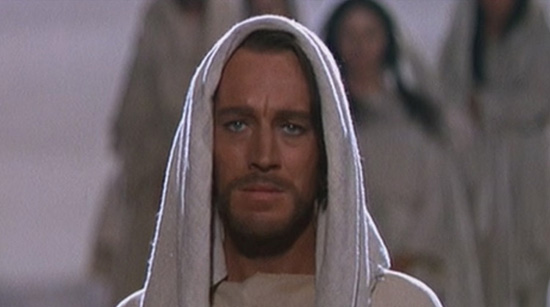
MAX VON SYDOW from THE GREATEST STORY EVER TOLD (1965)
The 50’s and 60’s saw an booming industry in Hollywood for Biblical epics. For years, it appeared that any biblical story was fair game for adaptation, leading to some of the most impressive cinematic wonders that have ever been committed to celluloid. Included among them is this George Stevens directed epic about the life of Christ, depicting his baptism (with Charlton Heston as John the Baptism) all the way to his Crucifixion. Like most of the movies of it’s era, The Greatest Story Ever Told was a star studded blockbuster, which was both a blessing and a curse; it unfortunately had the problem of miscasting several roles, including an awkwardly placed John Wayne as a Roman centurion, who utters the now infamous line, “Surely this man was the son of Gawd.” But, the movie did strike it rich with the excellent casting of legendary Swedish actor Max von Sydow as Christ. Sydow brings an intensity to the role that had never been seen before and it makes Jesus a compelling character throughout the film. From the gracefulness of his gentle ministry to the intense anger that he displays against the money changers at the Temple in Jerusalem, to the quiet vulnerability that he displays while being crucified, Sydow is compelling in the role from beginning to end, and he carries this sometimes uneven film on his sturdy shoulders. He also does an excellent job of giving the iconic look of Jesus the kind of expressiveness it needs to work in a more sophisticated cinematic outing. The movie is an odd mixture of old Hollywood melodrama, mixed in with a more modern sensibility towards the role of religion in our lives and how the image of Christ fits into that, and Sydow’s Jesus is a perfect match for that more modern image of Christ in our changing culture.
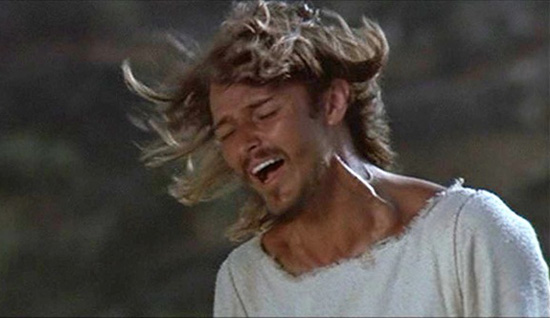
TED NEELEY from JESUS CHRIST SUPERSTAR (1973)
The 1970’s yet again was another shifting time for cultural attitudes towards religion, and this was reflected in some of the interesting ways that religion found it’s ways into movies at the time. In this Norman Jewison directed adaptation of Andrew Lloyd Webber and Tim Rice’s rock opera Jesus Christ Superstar, we saw a completely different kind of portrayal of Christ brought to the screen. Sure, it is kind of jarring to see Christ and his followers singing rock tunes out in the desert (shot on location in Israel), but the movie is still surprisingly respectful to the image of Christ, both scripturally and cinematically. Christ remains a figure of intense spiritual purity in this film, but it’s the aura that surrounds him that defines his power. Like the title of the film states, Christ’s persona gives him a superstar status among the people around him, giving him a cult of worshipers that he clearly struggles with. It’s a superstar status that makes him beloved, but also reviled, and he finds himself at odds whether remaining the savior for humanity is really something he should have resting on his shoulders. It’s a more conflicted side of Jesus than we’ve seen before, but one that still represents the spiritual power that we’ve seen before. Ted Neely, who was brought into the film after playing the role first on stage, clearly fits the image of Christ very well, and his impressive pipes give an interesting new intensity to the character as well. Funny how the image of Christ was not a huge leap to make from the usual aesthetic of the average hippie at the time of this film’s making. Neely had little more to do than just put on a robe and he becomes Jesus automatically; which literally does take place in the film’s opening minutes. It’s a product of it’s era, but still, an interesting new direction to take the persona of Christ into on the big screen.

WILLEM DAFOE from THE LAST TEMPTATION OF CHRIST (1988)
Here we have probably cinema’s most human depiction of Christ, which itself resulted in quite a bit of controversy. Adapted from Nikos Kazantzakis’ equally controversial book of the same name, Martin Scorsese’s film is an interesting spiritual examination of Jesus’ struggles with his own destiny. In this movie, Chirst knows he’s the son of God and that his purpose is to die for all the sins of humanity, and this is a burden on him that makes him feel distant from the rest of humanity. In his dying hours on the cross, Jesus asks God why he has forsaken him, and then the film stops to show what life would be like for Christ if he had denied his purpose and refused to sacrifice himself, instead choosing a normal life. This section itself was what stirred up the controversy behind the book and film, because it shows Christ in what some consider a sacrilegious portrayal; getting married, having sex, fathering children, and denying his divinity. But, many forget that in both cases these are just visions and not reality. Christ still dies on the cross like he was destined too, and everything we see beforehand is just a final temptation by the devil to coax him away from his destiny. Scorsese still considers himself a devout Christian, but he’s also an introspective filmmaker who wants to explore interesting concepts when it comes to religious themes, and that’s what attracted him to this film. He made a very wise choice in the casting of Willem Dafoe as Jesus, who gives the character a remarkable vulnerability that we have never seen before on film. Dafoe perfectly embodies a version of Jesus that is both frightened of his destiny and yet determined to see it through, and it’s that introspective view of the journey ahead that makes his performance so compelling. When he triumphantly smiles in the closing moments of the film and proclaims, “It is accomplished,” it is a powerful depiction of a man who has conquered evil, both on the outside and from within, and that makes for one powerful portrait of Jesus Christ.
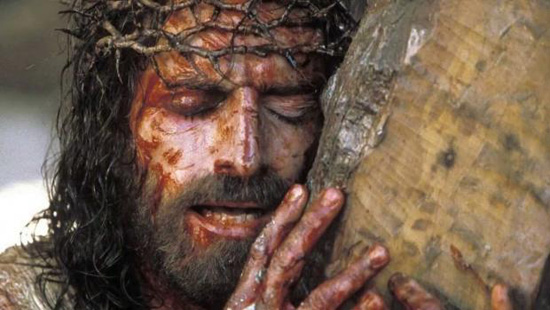
JIM CAVIEZEL from THE PASSION OF THE CHRIST (2004)
The other most controversial depiction of Jesus Christ is also the one that strives for the most accuracy. Mel Gibson’s often divisive portrayal of Christ’s torturous final hours is an interesting cinematic experiment, because it goes out of it’s way to recreate the period of time it is set in; even to the point of using dead languages in all of it’s dialogue. Whether that makes it historically accurate is debatable since it’s source of story comes from the Gospels. Still, it’s an interesting choice for a director to make in order to set their depiction of Christ apart from all the rest. Mel also cast largely unknown actors in most of the film’s roles, except for a couple exceptions; one being Jesus himself. The role of Christ went to established American actor Jim Caviezel, who took on the role based off of his own devout Catholic background. And like the person he was portraying, his own experience would turn into a test of faith. Not only did he have to endure long hours working outdoors in very little clothing, but he also endured some rather bizarre freak injuries while filming. At one point, one of the whips used in the scourging scene missed the padded protection on his back and actually cut a real gash on his side. And then during the crucifixion scene, he was struck by lightning in the middle of filming. Not to mention he had to learn to deliver all his lines in Aramaic. Suffice to say, this is a definitive example of an actor suffering for his art, but it does translate into a powerful performance on screen. Caviezel embodies a quiet strength as Jesus, enduring such horror but still remaining steadfast in his resolve. Whatever you think about the movie itself, you still have to admire the work that the actor put into it, making a determined attempt to be more true to the personage of Jesus than anything we’ve seen before.
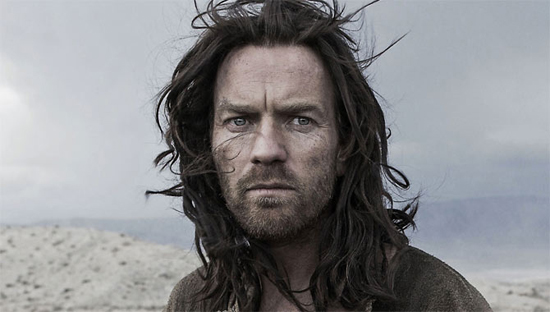
EWAN MCGREGOR from LAST DAYS IN THE DESERT (2016)
Here we have one of the more recent depictions of Christ on the big screen. The movie imagines a fictional encounter during Christ’s 40 days of fasting in the desert, where he is confronted by the devil and is told that he holds the fate of a family he has met on his journey in the balance. It’s a tight, simple narrative that nevertheless offers an interesting window in understanding the psyche of someone like Jesus. Ewan McGregor takes on the dual role of portraying Christ and the Devil (who is shown in the film as a twisted reflection of Christ, confident and sinister while Jesus remains doubtful but pure). His portrayal is a unique one, having his Jesus be someone who is still trying to understand his purpose. What’s more, his Jesus is someone who knows of his disconnect from humanity, having grown up without knowing his true father, and feeling frustrated with the fact that he is unable to communicate with him. This movie grapples with the notion of whether Christ was truly divine or not, and it’s dealt with in a very open-ended way. Jesus sees God’s signs everywhere, and he imagines the Devil by his side as a manifestation of all his doubt and anger, but in the end he is unsure if God really has set him apart for a reason, or if he may possibly not be there at all. And yet, the movie shows the eternal spiritual purity of Jesus, and how his journey would inform the spirituality of many more after him. McGregor gives Christ a very subtle humanity, one that doesn’t have to marry itself to all other depictions before it, and yet still remains true to the character. Here, he portrays a man seeking self discovery before his fully obtains the confidence to becoming the Savior of humanity. It’s interesting that the movie chose to explore the often overlooked period of Jesus’ fasting in the desert, because it’s really the best point to examine Jesus as a blank slate, something that Hollywood has rarely dared to tackle before.
So, there you have some of the many depictions of Christ that we have seen on the big screen. Interestingly enough, apart from these straightforward portrayals of Christ’s life on the big screen, you can still see his influence in a variety of other movies. You see it very clearly in the common cinematic trope of the Chirst-figure character; a main protagonist who is specially singled out by some mystical prophecy or fate that makes him the only person capable of destroying evil. Whether it is Neo from The Matrix (1999), Harry Potter from his wizarding world franchise, or Luke Skywalker in the Star Wars franchise, many of cinema’s most famous heroes have often fallen into this Christlike path of destiny. The Lego Movie (2014) mocked this trope perfectly by referring to it’s hero as “the Special.” Darth Vader from Star Wars can often be viewed as a Christ figure in reverse; a character of special significance whose destiny only leads him towards becoming more evil. But, despite how Hollywood has exploited and made fun of the Christ figure in cinematic history, you’ll never actually see an actual mockery of Christ the person. Even movies that do attempt it often do it through the misguided insanity of one of their characters, like “Buddy Jesus” in Kevin Smith’s Dogma (1999), which is representative of a ill-advised public relations campaign by a church to make religion appear more “hip.” Even the always irreverent South Park, which includes Jesus as a regular character, portrays him as a pure soul and a force for good. There can be many ways to do a bad portrayal of Christ on screen, but even some of the good ones can still draw the ire of some very devout followers. Regardless of where anyone stands on faith, we still have to acknowledge the importance of Christ as a symbol, both in everyday lives and in our art. He has remained a constant force on the big screen, and will so for many years to come, and it’s our responsibility as storytellers and filmmakers to make sure that his image is used only for the purposes of good in our world.